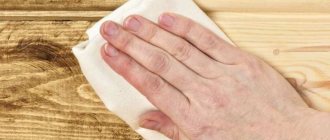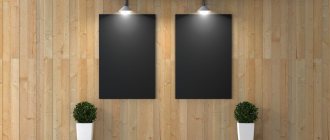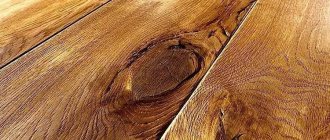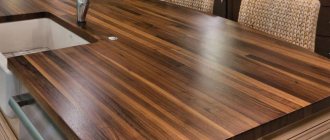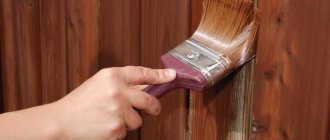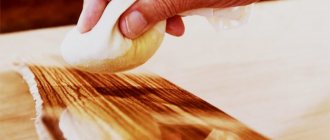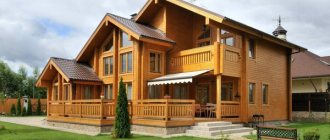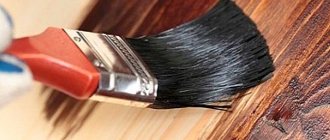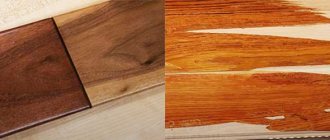Which brand should you prefer?
For reliable, aesthetically attractive finishing of wooden products, we use:
- High-quality polyurethane varnishes: Akzonobel and Hesse Lignal.
- Hard wax oils: Osmo and Saicos.
We came to this choice by testing numerous types of finishing mixtures and by observing changes in their characteristics during operation. For testing, we took products from 4 manufacturers:
- OSMO oils (premium price).
- BORMA oils (low price).
- SAICOS oils (average price)
- Polyurethane varnishes AKZONOBEL and Hesse Lignal (premium price).
General test results
The best results were shown by polyurethane varnishes: Akzonobel and Hesse Lignal and Saicos hard wax oil. Testing was carried out on oak panels. Water, wine, vodka were poured onto the surface, leaving the liquids for 5-30 minutes, 5 days, 1 month.
Test results:
- Akzonobel and Hesse Lignal varnishes withstand temperature effects better.
- Hot mugs and plates leave no marks on the varnish surface.
- The varnish is resistant to moisture penetration and leaves no marks when exposed to liquid for more than 5 days.
- Contamination from wine, juice, and other drinks on the varnish surface is easily removed.
- Osmo and Saicos hard wax oils do not absorb moisture for 5-30 minutes or more, but if you leave the liquid for more than 5 days, the water is absorbed and traces remain.
Characteristics for each brand
- Osmo - small traces of wine remain, no traces of vodka, spilled boiling water, or a mug of boiling water. There are no traces left after immersion in water for 30 minutes. With intense mechanical impact, minor marks appear.
- Borma - stains remain from wine, from vodka, from spilled boiling water. There are no traces of a mug of boiling water when immersed in water for 30 minutes. Significant marks remain from extreme mechanical stress.
- Saicos - no traces remain from wine, from vodka, from spilled boiling water, from a mug with boiling water, from immersion in water for 30 minutes. Minor marks are retained from extreme mechanical stress.
- AKZONOBEL and Hesse Lignal - no traces remain from wine, spilled vodka, spilled boiling water, a mug with boiling water, or immersion in water for 30 minutes. Minor marks from extreme mechanical stress.
Comparative strength qualities
- The oil penetrates deeply into the pores of the wood and protects it from the inside.
- Varnish creates a film on the surface of products and protects them from the outside.
- Wax forms an elastic, breathable film on the outside.
Varnishes and oils in combination with wax protect the surfaces of the product to approximately the same extent.
Varnish is considered more durable
It creates a strong film on the surface of the product, since its layer is somewhat thicker and denser than oil. However, it is precisely this quality that makes the varnish vulnerable.
Scratches on a varnished surface are more noticeable compared to an oiled surface.
Modern oils such as Saicos and Osmo, with the proper number of layers, also form a reliable, fairly strong protective film on the surface. At the same time, the oils we use are environmentally friendly.
Pros and cons of natural impregnation
When choosing how to treat a wooden floor or staircase, the environmental friendliness and protective properties of the impregnation are first taken into account. Impregnating wood with natural linseed oil has a number of advantages:
- The old product acquires an aesthetic appearance, as small cracks, abrasions and unevenness are masked.
- Absorbing into the porous surface, the composition gives it water-repellent properties.
- After drying, dust and dirt adhere less to the surface.
- Emphasizes the natural texture of wood.
- The oil has antiseptic properties and protects the surface from fungi, mold and blue stains.
- It is deeply absorbed into the wood and will last at least 50 years.
- Protects wood from cracking and drying out.
- Wood never stops “breathing”.
- Hypoallergenic and suitable as finishing in children's rooms and kitchens.
Linen is used to coat any wood products: in the processing of houses, when finishing furniture and decorative elements made of oak, teak, pine, spruce, fir. Due to its composition, the oil is easily combined with various tinting emulsions. Apply independently as finishing and protection or under further varnish coating.
The only downside is the price, which depends on the manufacturer and the volume of impregnation purchased. The table below presents the most popular manufacturers of linseed oil for finishing work:
Which wood oil to choose depends on your financial capabilities. An unrefined product from any manufacturer is suitable for wood processing. Imported flax compositions are more expensive, but have additives in the form of beeswax or artificial polymers.
They reduce drying time and simplify work. Each manufacturer has its own consumption and depends on the thickness of the product.
To tint the surface, impregnation with colors is purchased. This can be found in the catalogs of the manufacturer Tikkuril, price from 750 rubles/liter. Translucent tinting with various natural shades.
Using colored oil, you can tint an inexpensive type of wood, such as pine, or give the appearance of oak or mahogany. After processing, it will be difficult at first glance to distinguish inexpensive material from a similar premium class one.
Application of wax mastic
Wax-based mastic is the main product for caring for parquet floors. Parquet - both expensive and ordinary wood species are treated with beeswax-based mastics. The mastic is applied manually using a rag in a circular motion. The parquet is polished manually or with a grinding machine and a polishing wheel.
If the parquet is new, then the floors are treated with mastic 2-3 times. Between processing processes, technological breaks are taken to allow the next polishing layer to dry completely. The final coating is rubbed until the floor is shiny and glossy.
Selection rules
When choosing wax oil, consider the following points:
- Composition of the material . Experts recommend giving preference to products containing hard waxes, since they are refractory and have increased strength, which means a longer service life of the coating. In addition, when choosing a material, you should pay attention to the presence of allergens, which include orange oil, etc. It is not recommended to purchase such products, as they can provoke negative reactions in the body.
- Type of wood. The wax oil must be suitable for processing the specific wood from which the interior items are made. The appropriate markings are indicated on the material label.
- Furniture shade. Colorless products are suitable for all interior items. Colored materials are chosen depending on the shade of the product.
Expert opinion
Doshin Roman Valentinovich
Cabinetmaker, work experience - more than 15 years
Wood is the best material for making furniture. This is an environmentally friendly product, which indicates its safety for people. In addition, wood is easy to process, looks attractive and, with proper care, lasts for decades. The only “weak point” of the material is the lack of resistance to the harmful effects of moisture. However, this problem is easily solved by oil-wax. It creates a coating on the surface that protects furniture from moisture. The main thing is to choose a quality product. I recommend using hard wax based products. They are easy to apply, create a durable coating and have a melting point of +72-910C.
Myth 2: Dark wood oil lasts longer.
Among owners of wooden houses and even specialists in the field of wooden house construction, there is an opinion that the dark color of wood oil
will last longer, since there is more color pigment (color) in the coating, which means the surface will be better protected.
To be honest, at the very beginning of our professional journey we thought the same thing, but years of practice and more than one painted house showed that we were mistaken here.
Yes, the presence of a large amount of coloring pigment allows the coating to remain on the surface of the wood longer and better protect it from ultraviolet rays and precipitation, however, dark colors absorb almost all sunlight, which leads to strong heating of the wood, the formation of microcracks and, as a result, faster destruction of the oil or wax coating.
Unlike dark colors, light colors (not to be confused with colorless or translucent, containing a small amount of pigment) - white, yellow and light gray - reflect UV rays much better, heat the surface of the wood less and allow the oil to remain on it longer. Also, light-colored oils fade less than dark ones, so they better preserve the original appearance of the coating.
Of course, we should not forget that the above reasoning will be true only for facades and surfaces located in the open air, since indoors there is no such strong impact on wood as outdoors, which means oil for interior work
any color and coverage will last equally long.
Watch our video about the technology of painting a log house with wood oil.
Maintainability
If you do accidentally damage a parquet floor coated with oil and wax, you can correct the situation with minimal loss of time and money. When only the wax film is damaged, it is necessary to matte the damage with P150 abrasive, saturate the wood with another layer of oil and let it dry. If the scratch is deep all the way to the wood, more complex technologies are needed. For more detailed consultation on restoration, contact the company’s technologist. Comparing with other coatings, for example, parquet varnish, we note that if it is damaged, the surface will need to be completely sanded.
Impregnation of wood at home
You can also do wood impregnation yourself. To make such a mixture and apply it to wood, you will need the following tools:
- Oil and wax.
- Brush.
- Kitchen grater.
- Glass jar.
- Any heating element (for example, a gas stove).
- Large bowl (for heating wax and oil)
- Foam sponge and soft cloth (to remove excess moisture-resistant impregnation).
- Wooden or metal stick (for stirring the hydrophobic impregnation during heating).
- A wire brush, spatula, heat gun, sandpaper or any other available wood processing tools.
Peculiarities
Oil-wax is a material that affects both the structure of wood and its surface. As a result of its use, as already mentioned, a thin but durable coating is formed, which provides furniture with reliable protection from external negative influences, extending the service life of products without losing their visual appeal. At the same time, the product does not interfere with air circulation. Thanks to this, moisture does not accumulate under the coating and the process of wood rotting does not begin.
Oil-wax is a universal product recommended for use for interior work on any wood surface. Typically, the material is used for polishing interior items in high-traffic areas. The fact is that it forms a protective coating that prevents mechanical damage to surfaces.
In addition, the product has the following properties:
- levels the top layer of furniture;
- adds shine to the base, which improves the appearance of the products;
- prevents drying and cracking of wood.
Wax
Natural coating is suitable for all types of premises. Parquet wax forms a breathable protective layer that prevents the penetration of moisture, the development of fungi and destruction as a result of exposure to ultraviolet radiation.
Wax comes in 3 types:
- Solid . The substance has a dense texture and should be diluted with water before application. The density determines the final shade of the parquet.
- Liquid . Does not require dilution and is immediately applied to the work surface. Allows you to treat the most difficult to reach places.
- Pasta . The most convenient and popular type of wax. Apply with a brush or spatula.
The wood of the parquet blocks determines the choice of wax shade:
- Colorless . Does not affect the color of the parquet and emphasizes the unique features of the wood grain.
- Brightening . Available in silver-gray and white. Recommended for light wood species (maple, birch, ash), it shows good texture.
- Dark . Emphasizes natural shade. Suitable for dark woods (cherry, oak).
To apply wax, you do not need special knowledge or tools. Only the final stage—polishing—requires special attention. The wax dries in about 14 days; complete impregnation takes about a month.
Floors with such a coating require careful handling due to their tendency to mechanical damage. Wet cleaning is carried out exclusively with professional means.
The wax layer is renewed approximately once every 6-8 months; no grinding preparatory procedures are required. The repair is similar to an oil-impregnated coating.
